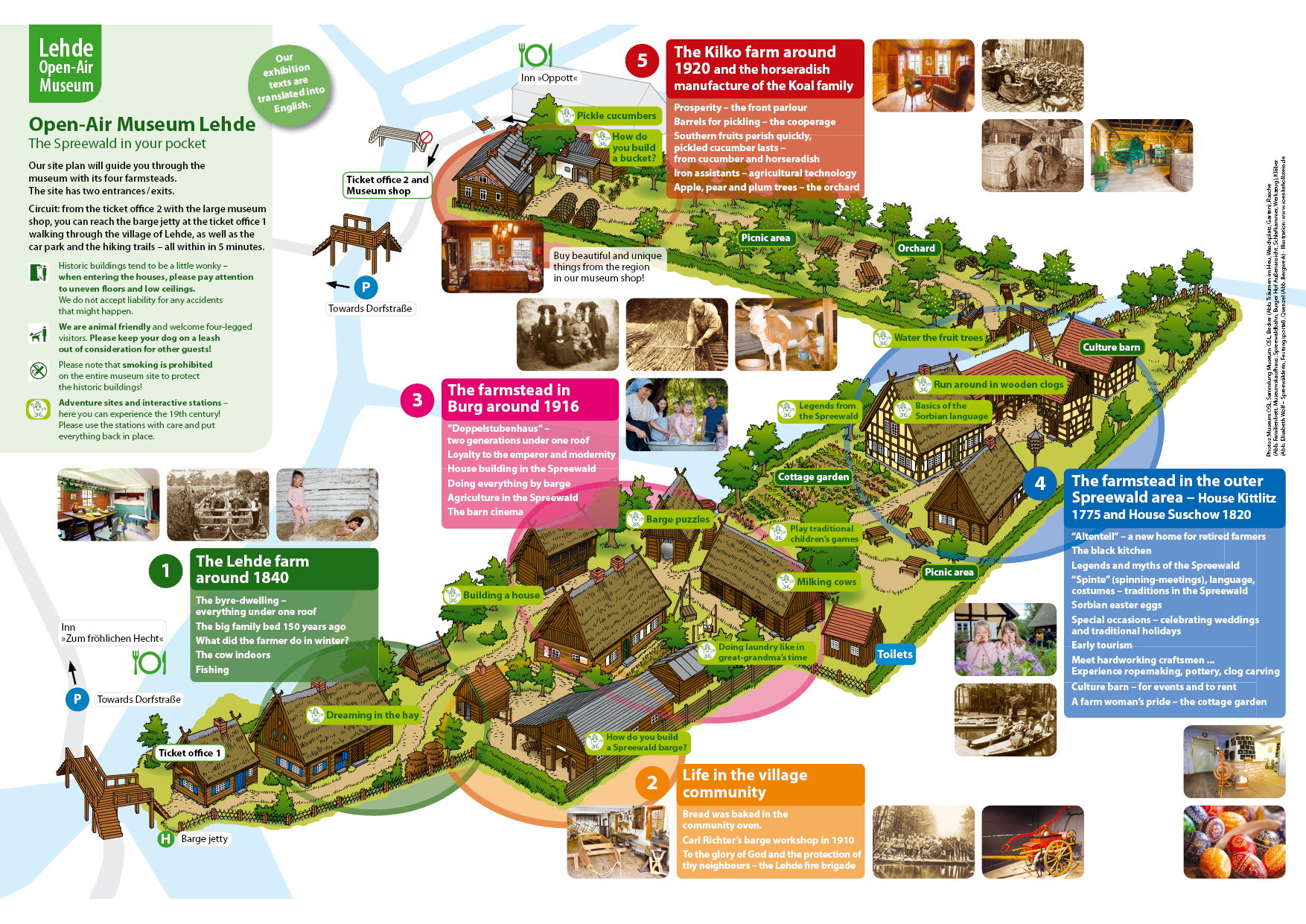Welcome to the 19th century!
Join us on a journey through the diverse Spreewald cultural landscape and discover typical houses and farms in the villages of Lehde, Burg and in the outer Spreewald.
Four historic farmsteads have been rebuilt here in the heart of Lehde. You can see rooms furnished in original style and experience rural community life and work in the 19th and early 20th centuries.
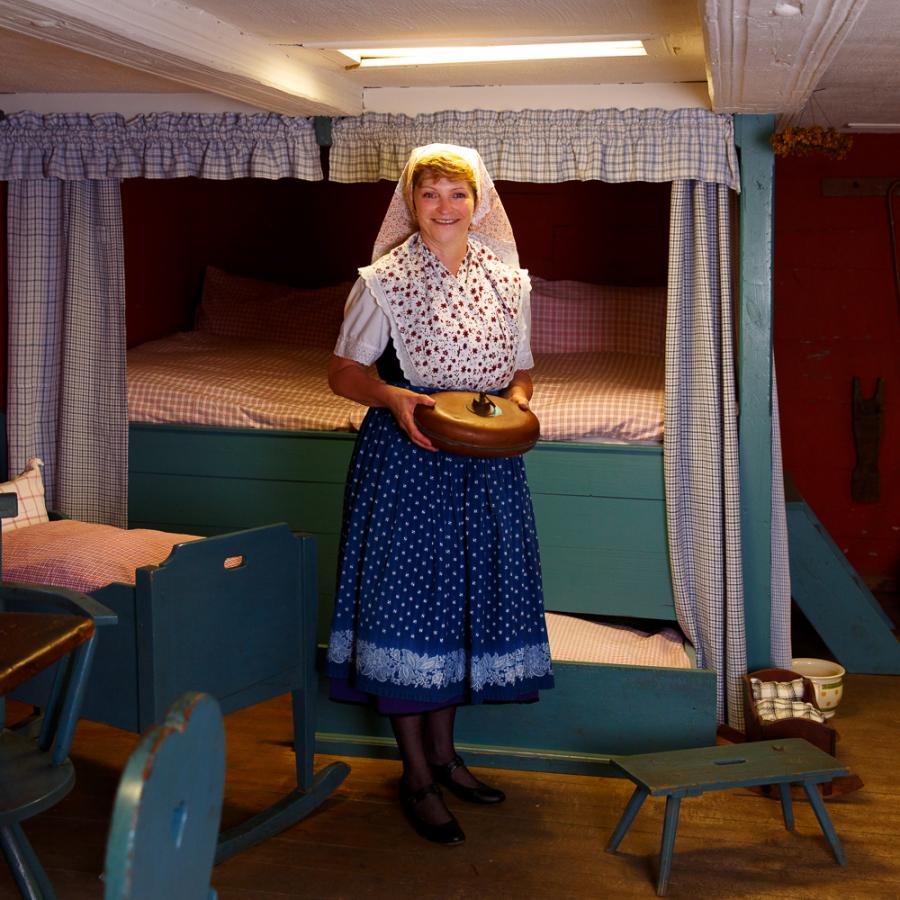

The Lehde farm (Ledy) around 1840
The heart of the Spreewald consists of a myriad of waterways and little islands. Farmers’ lives are governed by the flow of water and the turning of the seasons. In 1840 everything really happened “under one roof” on the farm in Lehde. Discover the big bed where the whole family slept. The family lived in a farm house known as a “byre-dwelling”, which they shared with the livestock. Find out what the farmer did in winter and what the cow was up to indoors. Where there is water, there are also fish. Spreewald residents enjoyed an abundance of fish.
- The byre-dwelling – everything under one roof
- The big family bed 150 years ago
- What did the farmer do in winter?
- The cow indoors
- Fishing
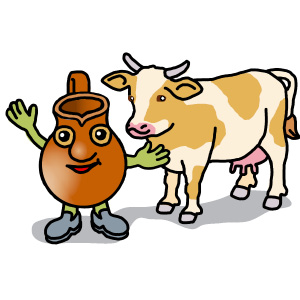
Adventure sites and interactive stations
- Dreaming in the hay
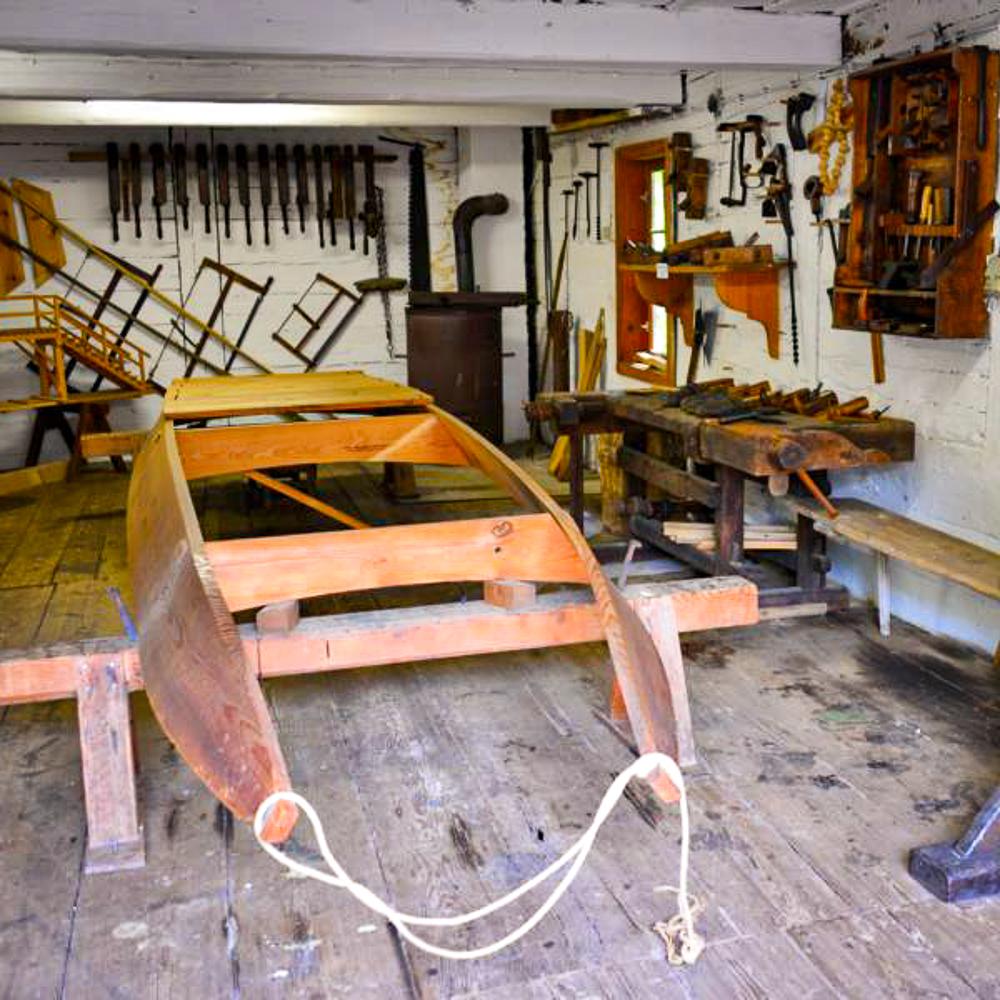

Life in the village community
Baking, celebrating, everyone pitching in – good neighbours are especially important if you live in isolated areas like the Spreewald of the 19th century. The village had a communal bakery. Here local people baked bread together every two to four weeks. Community cooperation was particularly important when disaster loomed. Discover the historical fire-fighting equipment of the Lehde fire department and find out what night watchman’s duties were. You can find out why the barge builder replaced the farrier in the Spreewald village. Learn how a real Spreewald barge was constructed in the oldest barge workshop in Lehde.
- Bread was baked in the community oven.
- Carl Richter’s barge workshop in 1910
- To the glory of God and the protection of thy neighbours – the Lehde fire brigade
 Adventure sites and interactive stations
Adventure sites and interactive stations
- How do you build a Spreewald barge?
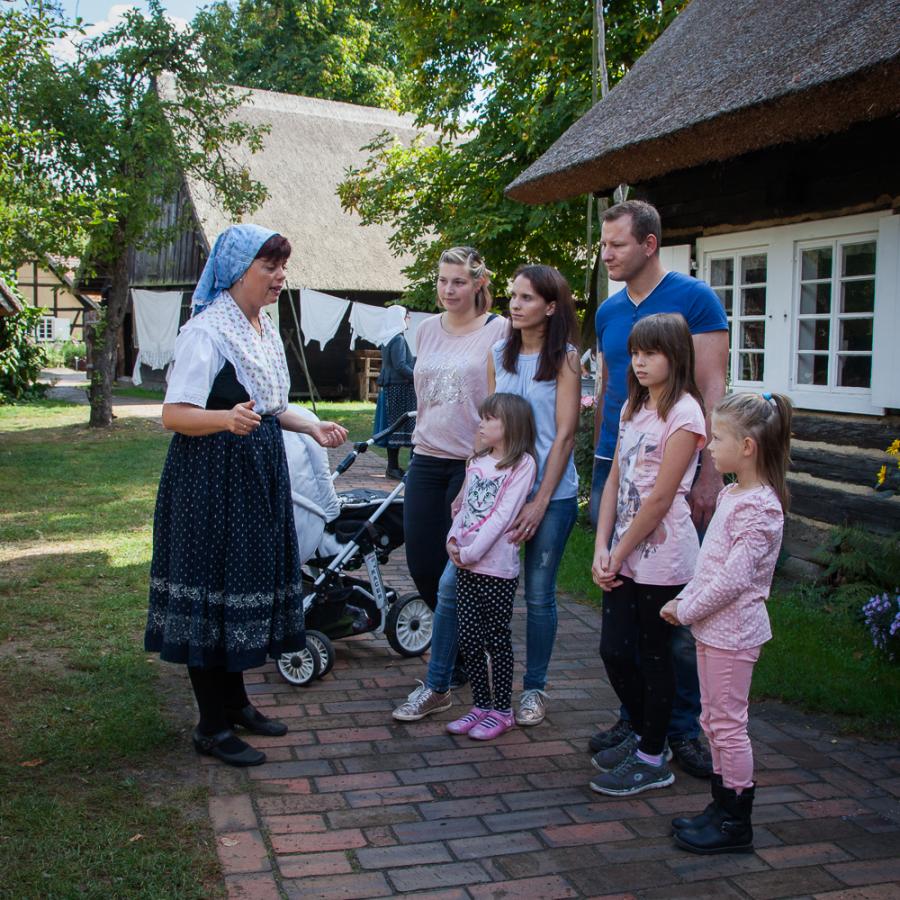

The courtyard in Burg (Bórkowy) around 1916
The “double living area house” from Burg gives an idea of how the modern era and the effects of war suddenly arrived in the Spreewald area in 1916. The courtyard complex includes the small gallery stall, the stable barn, barge shed and a washing area where the laundry is washed with soap and washboard, just like in our great-grandmothers’ day. At the adventure sites we show you how a Spreewald log house is built and how thatched roofs protect against rain and sun. Find out how the farmers in Burg made a living from agriculture, try milking a cow yourself and learn in the barn cinema how cucumbers thrive in the Spreewald.
- "Doppelstubenhaus" - Two generations under one roof
- Loyalty to the emperor and modernity
- House building in the Spreewald
- Everything to do with barges
- Agriculture in the Spreewald
- The barn cinema

Adventure sites and interactive stations
- Building a house
- Doing laundry like in great-grandma’s time
- Barge puzzles
- Milking cows
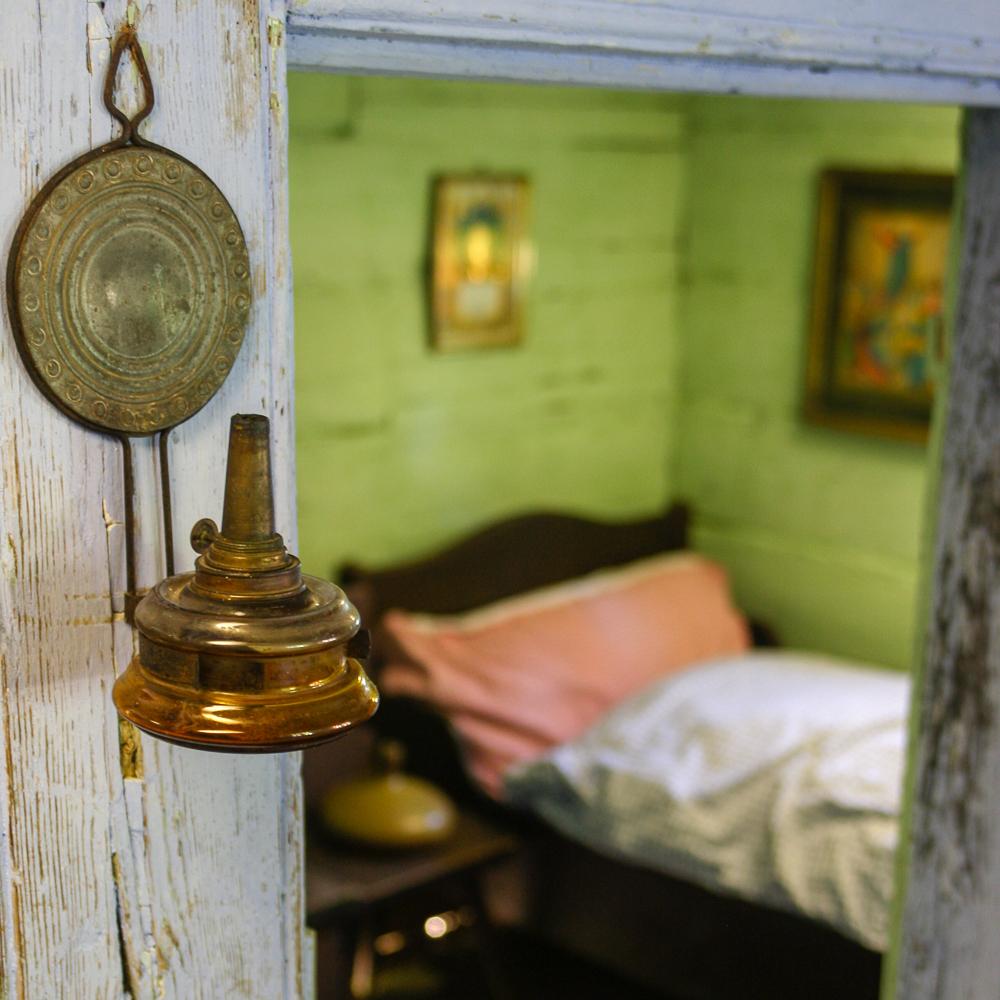


The farmstead in the outer Spreewald area – House Kittlitz (Dłopje) from 1775 and House Suschow (Zušow) from around 1820
The farmstead in the outer Spreewald area consists of the oldest building in the museum, the Kittlitz house from 1775, the gallery stable, where you can discover the traditional handicrafts of potters, rope makers and clog makers, as well as the Suschow house, where elderly farmers lived in their retirement. It shows life around 1820 with a tiled stove and “black kitchen”. In the cottage garden you will find medicinal herbs, Spreewald vegetable plants and colourful flowers. Tasting is allowed!
In Haus Kittlitz you will hear some old Spreewald legends and learn about customs and traditions such as Sorbian Easter eggs and local festivals and celebrations. Meet Spreewald residents and get to know their culture: Sorbian language and music, the “Spintestube” (spinning room), the traditional costume. Find out how the Spreewald first became a tourist hotspot.
- A whole house for elderly farmers
- The black kitchen
- Legends and myths of the Spreewald
- “Spinte” (spinning), language, traditional costume – traditions in the Spreewald
- Easter egg art
- For special occasions – celebrate marriages and organise parties here
- Early tourism
- Meet hardworking craftsmen ...
- Experience ropemaking, pottery, clog carving
- Rent and hold your event in our culture barn
- The farmer woman Zier – the cottage garden

Adventure sites and interactive stations
- Play traditional children’s games
- Legends from the Spreewald
- Basics of the Sorbian language
- Run around in wooden clogs


The Lehde farm (Ledy) around 1920 and the horseradish manufacture of the Koal family
The Kilko farm in the village of Lehde tells the story of how a Spreewald farmer got rich. The famous Spreewald vegetables cucumber and horseradish had starring roles in this story. Koal family’s horseradish manufacture with its historical machines shows how the vegetables got from the field into jars. Here you can find out what makes pickled Spreewald cucumbers and hot horseradish so special. Discover in the cooperage how wooden barrels are made.
- Prosperity – the front parlour
- Barrels for pickling – the cooperage
- Southern fruits perish quickly, pickled cucumber lasts – from cucumber and horseradish
- Iron assistants – agricultural technology
- Apple, pear and plum trees – the orchard

Adventure sites and interactive stations
- Water some fruit trees
- How do you build a bucket?
- Pickle cucumbers
